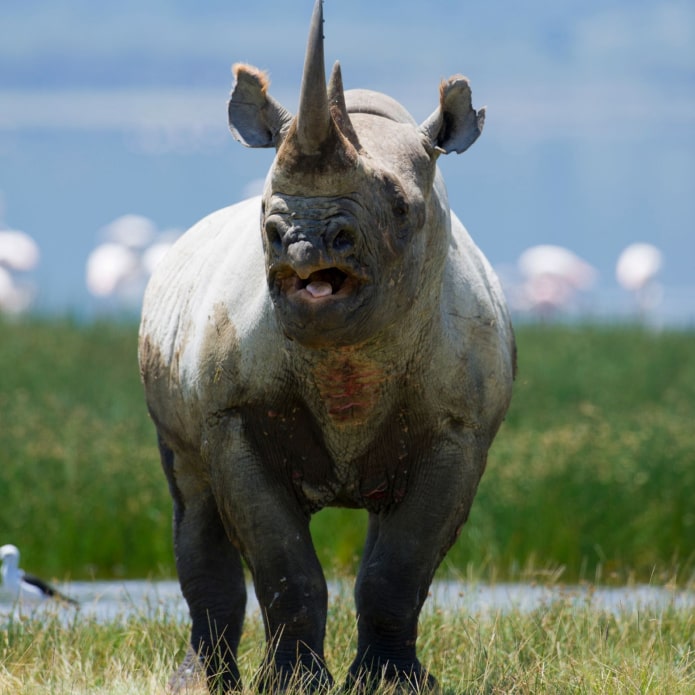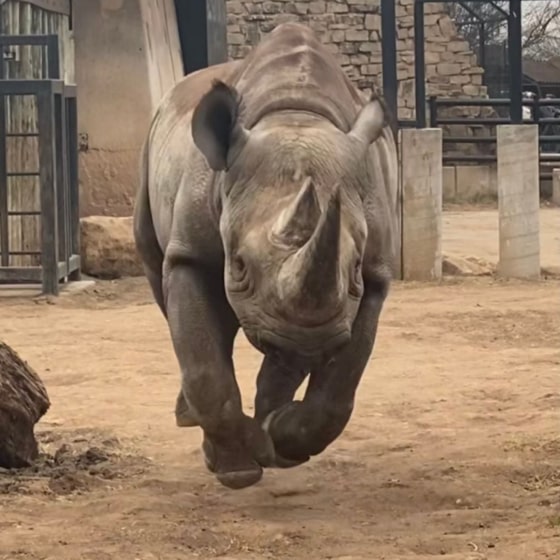The Southern Black Rhino is an indomitable giant! Known scientifically as Diceros bicornis minor, it is a subspecies of the Black Rhino whose footprints are etched powerfully on Southern African soil.
Unfortunately, the Southern Black rhino has fallen victim to excessive poaching and habitat destruction and almost succumbed to their devastation. At one time, this subspecies was on the brink of extinction. Fortunately, global conservation efforts saved it from eternal obliteration, paving the way for the slow but steady restoration we’re witnessing in its numbers.
In 2024, the Southern Black Rhino continues to thrive magnificently in the hands of dedicated researchers and wildlife managers who pour their souls into its care. It’s a living testimony to the transformative impact of wildlife conservation and management efforts.
Diet
Southern Black Rhinos are browsers. They feed on leaves, branches, shrubs, and herbs. Their prehensile upper lip allows them to firmly grasp and pluck vegetation, making them highly efficient at feeding on various plant species. This diet is enough to sustain their massive size.
Unlike their grazing counterparts – the Southern White Rhinos – which mainly graze, the Southern Black Rhinos have the advantage of thriving in areas where grasses are scant but shrubs and trees are plentiful.
Habitat
Southern Black Rhinos inhabit diverse landscapes, including the savannas, grasslands, and tropical bushlands of South Africa, Zimbabwe, and Mozambique. They prefer areas with dense vegetation, which provides both food and cover from predators and poachers. The Southern Central Black Rhino, another subspecies, shares similar habitats but can also be found further north in Central Africa.
Size and Weight
Adult Southern Black Rhinos are enormous creatures, with males weighing between 1,800 to 3,000 pounds and females slightly lighter. They’re about 4.5 to 5.5 feet tall at the shoulder and can reach lengths of up to 12 feet. In comparison, the Southern White Rhino is generally larger, with more pronounced differences in size and weight.
From birth, Southern Black Rhino calves, which weigh between 80 to 110 pounds, are primed for the arduous environments they’ll inhabit, so they build strength and resilience early.
Migration
Movement among Southern Black Rhinos is more seasonal and local as opposed to long-distance. They are known to go beyond their established territories during dry spells, spurred by a scarcity of resources.
Sometimes, these pursuits of nourishment push these solitary giants to interact with other wildlife, such as elephants and antelopes, as they often share watering points and grazing areas.
Conservation Status
The Southern Black Rhino is currently listed as Critically Endangered by the IUCN.
Its population has declined considerably and there’s a need for all resources to be channeled toward anti-poaching measures, habitat restoration, and the implementation of stringent laws that will curb their dwindling population.
Visit Abilene Zoo today and learn more about the Southern Black Rhino while supporting our initiative to further rhino conservation!

Native to southern Africa, these solitary animals live in brush and scattered open woodlands of the savanna
Southern Black Rhinos feast on leaves, twigs, shrubs, and herbs. What makes the Southern Black Rhino unique is its prehensile lip. The top lip of their mouth acts like a finger that helps grab leaves and branches.
Southern black rhinos can charge at speeds of up to 30 mph
Although they have poor eyesight, their sense of smell and hearing is excellent. They can swivel their ears in all directions picking up noises from far off in the distance. These territorial animals make their home around watering holes, and self-made mud wallows.


FAQ
How many southern black rhinos are left?
The southern black rhino is a critically endangered species. As of the latest data, approximately 6,500 southern black rhinos are left in the wild. This number reflects a significant recovery from the species’ historic low of fewer than 2,500 individuals in the mid-1990s, thanks to dedicated conservation efforts across Africa.



